“Global High-tech Logistics Market to reach a market value of 95.2 Billion by 2031 growing at a CAGR of 11.6%”
The Global High-tech Logistics Market size is expected to reach $95.2 billion by 2031, rising at a market growth of 11.6% CAGR during the forecast period.
The Europe segment procured 30% revenue share in the high-tech logistics market in 2023. Europe has been a hub for high-tech logistics innovation, with countries like Germany, France, and the UK leading in adopting smart warehousing, automated logistics systems, and sustainable transportation solutions. The region's focus on sustainability and the development of green logistics solutions, along with the implementation of stringent regulations on carbon emissions, has further fueled the growth of the high-tech logistics market in Europe.
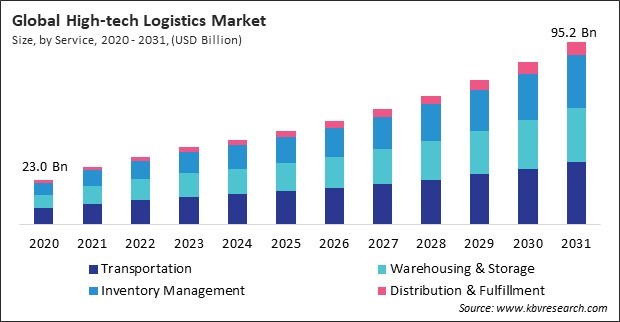
The major strategies followed by the market participants are Product Launches as the key developmental strategy to keep pace with the changing demands of end users. For instance, In June, 2024, Cosco Shipping Lines Co. Ltd. unveiled an initiative focused on adopting digital technologies, enhancing the industry ecosystem through AI and blockchain, prioritizing efficiency and customer experience, and committing to green development by investing in clean energy and emissions reduction to achieve net-zero goals. Moreover, In July, 2024, C.H. Robinson Worldwide, Inc. unveiled Digital Dispatch, a data science and AI-powered platform for real-time load matching. In a competitive freight market, it provides carriers with instant access to relevant loads, helping them secure the best options for their network and resulting in improved business outcomes and customer service.
Based on the Analysis presented in the KBV Cardinal matrix; FedEx Corporation and Deutsche Post DHL Group are the forerunners in the High-tech Logistics Market. In August, 2024, FedEx Corporation unveiled FedEx Surround, a logistics solution using AI, ML, and advanced sensors like SenseAware ID for real-time shipment monitoring and intervention. SenseAware ID transmits location data every two seconds via BLE, offering enhanced visibility and control by tracking packages hundreds of times within the FedEx network. Companies such as DP World Logistics FZE, A.P. Moller - Maersk A/S, and Cosco Shipping Lines Co. Ltd. are some of the key innovators in High-tech Logistics Market.
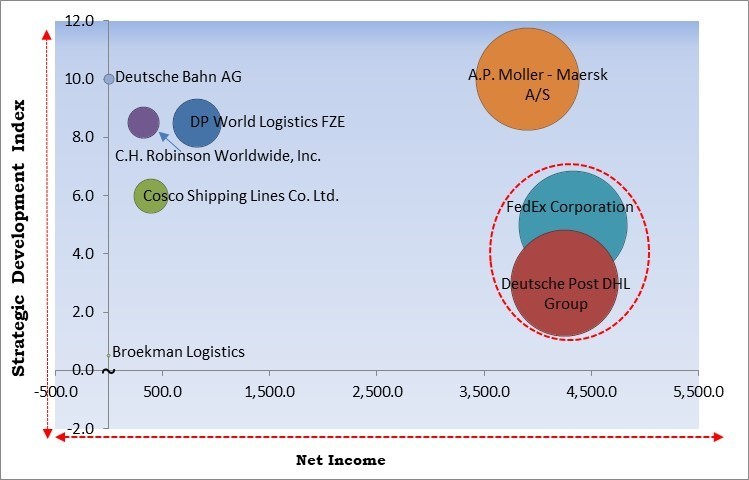
Supply chain operations are being transformed by the heightened demand for automation and artificial intelligence (AI) in logistics, which is signifying a transition from manual processes to highly efficient, automated systems. The logistics sector is increasingly reliant on automation, as it is essential for ensuring efficiency, accuracy, and speed. Automated technologies such as robotic sorting, automated picking systems, and AI-driven decision-making drastically reduce human error, minimize delays, and optimize the logistics chain. Hence, logistics companies embracing automation and AI will continue to propel the market's growth.
Additionally, The logistics industry has been fundamentally transformed by the rapid development of the e-commerce sector, which has compelled providers to adopt more reliable, flexible, and fast delivery options in order to meet the increasing expectations of customers. According to the United Nations Conference on Trade and Development (UNCTAD), global e-commerce sales surged to $26.7 trillion in 2020, highlighting the immense scale of online retail globally. Thus, the continuous growth of both domestic and cross-border e-commerce is pushing logistics providers to invest heavily in high-tech infrastructure and solutions, thereby supporting the expansion of the market.
Setting up advanced logistics systems often requires the integration of cutting-edge technologies such as artificial intelligence (AI), the Internet of Things (IoT), and automation, all of which demand a substantial upfront financial commitment. These systems typically involve sophisticated hardware like sensors, automated machinery, and robotics, alongside the deployment of specialized software designed for real-time data tracking, route optimization, and supply chain analytics. Hence, because of these factors, the overall growth of this market may be hampered.
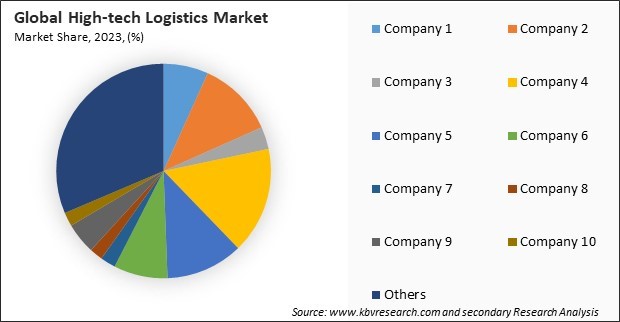
The leading players in the market are competing with diverse innovative offerings to remain competitive in the market. The above illustration shows the percentage of revenue shared by some of the leading companies in the market. The leading players of the market are adopting various strategies in order to cater demand coming from the different industries. The key developmental strategies in the market are Product Launches and Product Expansions.
On the basis of industry, this market is divided into semiconductor industry, consumer electronics, medical devices, telecommunications equipment, and aerospace & defense technologies. The consumer electronics segment recorded 28% revenue share in this market in 2023. With the continuous rise in demand for smartphones, tablets, laptops, and smart home devices, logistics providers handled large volumes of products and ensured timely delivery to meet market demands.
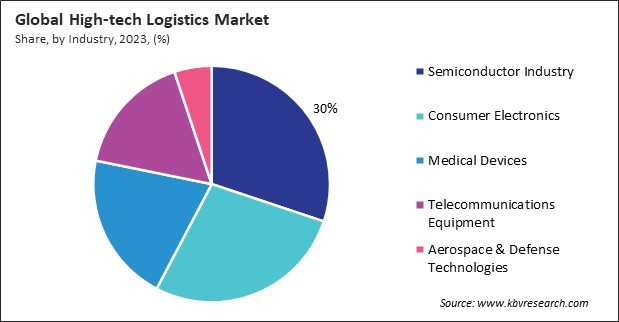
Based on service, this market is classified into transportation, warehousing & storage, inventory management, and distribution & fulfillment. The warehousing & storage segment procured 31% revenue share in this market in 2023. The growing adoption of smart warehousing solutions, including robotics, IoT-enabled sensors, and AI-powered inventory systems, helped logistics providers optimize storage space and reduce operational costs. The demand for efficient warehousing solutions has been driven by the need to store and manage a higher volume of goods, particularly with the rise of e-commerce and global trade.
Free Valuable Insights: Global High-tech Logistics Market size to reach USD 95.2 Billion by 2031
Region-wise, this market is analyzed across North America, Europe, Asia Pacific, and LAMEA. The North America segment garnered 37% revenue share in this market in 2023. The region’s advanced logistics infrastructure drove this, with the presence of major e-commerce giants like Amazon and Walmart and the widespread adoption of cutting-edge technologies such as autonomous vehicles, AI-powered route optimization, and IoT-enabled tracking systems.
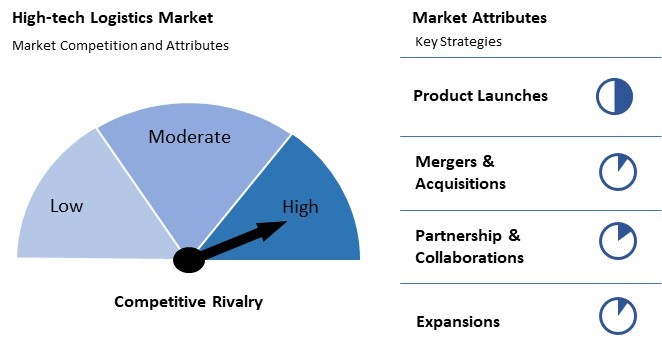
Competition in the high-tech logistics market is High, driven by rapid technological advancements and evolving customer demands. Companies focus on integrating automation, AI, and data analytics to enhance efficiency, reduce costs, and improve delivery speed. Small to mid-sized firms innovate to compete with major industry leaders through specialized solutions and customer-centric services.
| Report Attribute | Details |
|---|---|
| Market size value in 2023 | USD 40.2 Billion |
| Market size forecast in 2031 | USD 95.2 Billion |
| Base Year | 2023 |
| Historical Period | 2020 to 2022 |
| Forecast Period | 2024 to 2031 |
| Revenue Growth Rate | CAGR of 11.6% from 2024 to 2031 |
| Number of Pages | 214 |
| Tables | 294 |
| Report coverage | Market Trends, Revenue Estimation and Forecast, Segmentation Analysis, Regional and Country Breakdown, Competitive Landscape, Market Share Analysis, Porter’s 5 Forces Analysis, Company Profiling, Companies Strategic Developments, SWOT Analysis, Winning Imperatives |
| Segments covered | Service, Industry, Region |
| Country scope |
|
| Companies Included | C.H. Robinson Worldwide, Inc., FedEx Corporation, DP World Logistics FZE (SeaRates), Deutsche Post DHL Group (The Deutsche Post AG), Deutsche Bahn AG (DB Schenker), A.P. Moller - Maersk A/S, Burris Logistics, Wings Logistics Canada, Inc., Cosco Shipping Lines Co. Ltd., and Broekman Logistics |
By Service
By Industry
By Geography
This Market size is expected to reach $95.2 billion by 2031.
Increased Demand For Automation And Ai are driving the Market in coming years, however, High Initial Investment Costs Of High-Tech Logistics restraints the growth of the Market.
C.H. Robinson Worldwide, Inc., FedEx Corporation, DP World Logistics FZE (SeaRates), Deutsche Post DHL Group (The Deutsche Post AG), Deutsche Bahn AG (DB Schenker), A.P. Moller - Maersk A/S, Burris Logistics, Wings Logistics Canada, Inc., Cosco Shipping Lines Co. Ltd., and Broekman Logistics
The expected CAGR of this Market is 11.6% from 2024 to 2031.
The Transportation segment captured the maximum revenue in the Market by Service in 2023, thereby, achieving a market value of $32.6 billion by 2031.
The North America region dominated the Market by Region in 2023, and would continue to be a dominant market till 2031; thereby, achieving a market value of $34.1 billion by 2031.
Our team of dedicated experts can provide you with attractive expansion opportunities for your business.

 Drivers
Drivers
 Restraints
Restraints
 Opportunities
Opportunities
 Challenges
Challenges
